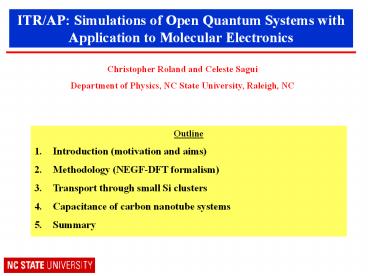ITR/AP: Simulations of Open Quantum Systems with Application to Molecular Electronics - PowerPoint PPT Presentation
Title:
ITR/AP: Simulations of Open Quantum Systems with Application to Molecular Electronics
Description:
ITR/AP: Simulations of Open Quantum Systems with Application to Molecular Electronics Christopher Roland and Celeste Sagui Department of Physics, NC State University ... – PowerPoint PPT presentation
Number of Views:70
Avg rating:3.0/5.0
Title: ITR/AP: Simulations of Open Quantum Systems with Application to Molecular Electronics
1
ITR/AP Simulations of Open Quantum Systems with
Application to Molecular Electronics
Christopher Roland and Celeste Sagui Department
of Physics, NC State University, Raleigh, NC
- Outline
- Introduction (motivation and aims)
- Methodology (NEGF-DFT formalism)
- Transport through small Si clusters
- Capacitance of carbon nanotube systems
- Summary
2
Discovery of MWNT (Iijima, Nature)
Conductivity (Hamada, PRL)
Synthesis of SWNT (Iijima, PRL, Bethune, PRL)
Field Emitter(Choi, APL)
Ropes (Thess Science)
Quantum Conductance(Tans, Nature)
Superconductivity (Kociak, PRL))
3
A Catenane-based Solid-State Switch
- a solid-state, electronically addressable,
bistable molecular switching device working at
ambient conditions
Ref A 2-catenane-based solid-state
electronically reconfigurable switch, C.P.
Collier et al, Science 289, 1172 (2000)
4
Transport Through Biomolecules
Here we present measurements of electrical
transport through individual 10.4nm long,
double-stranded poly(G)-poly(C) DNA molecules
connected by two nanoelectrodes that induce, by
contrast large-bandgap semiconducting behavior
Ref Direct measurement of electrical transport
through DNA molecules, D. Porath, A. Bezryadrin,
S. de Vries, and C. Dekker, Nature 403, 645
(2001).
5
What fundamental aspects of molecular-scale
devices need exploration ?
What principles underlie the operation of
nanoscale devices? What controls current flow in
molecules ? What classes of molecules make good
devices and sensors? How to best deal with
interactions, far-from equilibrium effects,
dynamic response, spin effects, nonlinear
coupling of devices, ?
Ultimately, one wants to predict the quantum
transport characteristics with as few adjustable
parameters as possible !
6
Molecular devices and open quantum systems
Left Lead
Right Lead
Effective Scattering Region
- Main Problems
- How to reduce this infinite system to something
that is calculable on the computer? - How to self-consistently calculate the charge
density in the presence of an external bias
potential ( intrinsically a nonequilibrium
situation)
7
Theoretical Approaches to Quantum Transport
- Semi-empirical methods non-selfconsistent
methods, typically involving tight-binding
Hamiltonians (many authors) - Ab initio supercell methods solve Kohn-Sham
equations with periodic boundary conditions good
way to calculate conductances, but not I-V curves
(e.g., Choi and Ihm, PRB 59, 2267 (1995) and
others) - Lippman-Schwinger approach typically leads are
Jellium based with charge density constructed
from scattering states (Lang and coworkers) - Nonequilibrium Greens function approach
combined with DFT (Taylor, Guo, and Wang, PRB 63,
245407 (2001))
8
Advantages of DFT-NEGF Approach
- Ability to deal with open quantum system at a DFT
level - Self-consistent calculation of the charge density
under a bias voltage by means of a NEGF, in order
to include contributions of both scattering and
bound states - Ability to treat system with true atomistic
leads - Formalism is based on real-space grids, so that
system is scalable and treatment of large systems
possible
9
ITR Scientific Aims
- Develop NEGF-DFT formalism as to enable
scientific investigations of paradigmatic
molecular electronic devices - multiprobe configurations ( for Y, T
junctions, crossed nanowires, ) - spin effects (for transport through magnetic
clusters, spintronic systems, magnetic tunnel
junctions ) - dynamic response (for ac fields, quantum pumps
and turnstiles, time-dependent phenomena) - applications (functionalized organics and
biomolecules)
10
Ab Initio Calculations of Molecular I-V
Characteristics
- Plot of an Al (100)/Si10/Al (100) molecular
device - Contour plot of the equilibrium charge density
11
Ab Initio I-V Characteristics of Sin Clusters
- calculated I-V curves of small Sin, n 1-10,
13, 20 clusters between Al and Au leads - Behavior of all clusters is fairly similar,
especially at small voltages - nonlinear effects, including negative
differential resistance observed for voltages
greater than ? 0.6 V
Si7
Si4
Ref Charge transport through small silicon
clusters, C. Roland el al, Phys. Rev. B 66,
035332 (2002).
12
Transmission Coefficients T(E,Vb) for Si Clusters
Band structure of Al leads (left panel), with
corresponding transmission coefficients (right
panel). Wavevectors corresponding to scattering
states are marked in red RMLs are marked on
right panel with filled circles
13
Which molecular levels mediate transport?
- for an isolated molecule, we can diagonalize the
Hamiltonian matrix to get the molecular levels - for an open molecular device system, this is
impossible to do
- rather, we concentrate on finding the
renormalized molecular levels or RMLs
- RMLs are found by diagonalizing the submatrix
corresponding to the self-consistent device
Hamiltonian matrix that corresponds to the
molecular region - RMLs are responsible for molecular conduction!
14
Capacitance at the Nanoscale
- at the nanoscale, the screening length of the
system is comparable to the dimensions of the
system, and so the classical concepts of
capacitance are inadequate - use notion of electrochemical capacitance
- i.e., the charge variation dQ? when
electrochemical potential of reservoir connected
to conductor ? is changed by small amount d??
- C?? are self-charging coefficients C?? are
mutual-charging terms - calculations as before, but now we surround
system with metal box (needed to contain electric
field lines, and deal with charged system)
15
Ab Initio Investigations of Capacitance at the
Nanoscale
Aim at the nanoscale, the screening length of
material is comparable to the dimension of the
system, so that classical concepts need
modification generalize to electrochemical
capacitance
Methodology use the recently developed DFT-NEGF
16
Other paradigmatic examples
Inserting (5,5) into (12,12) tube
(12,0)/(6,6) junction memory device
Nanotubes as scanning capacitance probes
Ref First principles investigation of carbon
nanotube capacitance, P.Pomorski et al, Phys.
Rev. B 67, RC161404 (2003) Capacitance, induced
charges, and bound states of biased carbon
nanotube systems, PRB 69, 115418 (2004).
17
Summary
Aim is to investigate open quantum systems, with
application to molecular electronic systems, by
means of a recently developed NEGF-DFT
formalism Examples I-V characteristics of
Si-cluster based devices Capacitance of carbon
nanotubes

